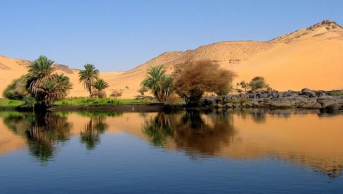Water Management in Transboundary Basins as a “Wicked Problem”? The Case of Orontes Transboundary River Basin
A workshop to discuss the Orontes River Basin was convened at MEF University, Istanbul, Turkey, during November 12-14, 2014. Workshop attendees from the countries of Orontes River Basin highlighted the need for a reappraisal of not only the problems faced and but also the solutions proposed. The meeting was, indeed, a reminder of how the enduring complexities of the issues embedded in a transboundary river basin setting might look like.
The Orontes River (known in Turkish as “Asi Nehri”, in Arabic as “Nahr-al Asi”) originates at an altitude of 690 metres near the city of Baalbek, in the northern Bekaa region of Lebanon. It enters Syrian territory and passes through the cities of Homs and Hamah. Crossing through the fertile region of Al-Ghab where intensive irrigation systems have been established, Orontes then constitutes 56 km of the Syrian-Turkish border and enters into Turkey. It finally discharges into the Mediterranean Sea in Hatay Province of Turkey. The data concerning total length and catchment area of Orontes is variable across different sources. According to a recent study using satellite images at an altitude of 2,000 meters calculated the total length as 556 km, of which 40 km are in Lebanon, 366 km in Syria, and 98 km in Turkey (1). It has a catchment area of 17,000 km2 to 37,900 km⊃2;.
The multi-layered nature of problems experienced in the Orontes River Basin could be better understood with the term “wickedness”. Wicked problems have been thought of as having a number of defining characteristics. This briefing conceptualizes the wickedness of the problems in Orontes River Basin around the eight features as have been listed by the Australian Public Service Commission(APC). According to APC, wicked problems generally have the following characteristics: 1. Difficult to clearly define; 2. There are many interdependencies and multi-causal aspects; 3. Proposed measures may have unforeseen effects; 4. Problems may be unstable and continue evolving; 5. No clear and correct solution; 6. Problems are socially complex with many stakeholders; 7. Responsibility stretches across many organizations; 8. Solutions may require behavioral changes by citizens and stakeholder groups.
Discussions not only on long-lasting, but also on newly emerging problems in the transboundary basin of Orontes River unfold through all of these features.
First, the real problem in the Basin appears to be difficult to clearly define. There is no consensus on whether ecosystem protection, or transboundary water sharing, or land-use related problems, or water scarcity lies at the heart of the problem. What is the problem? Answering to this very basic question -beside being quite difficult, if not impossible- will shape the nature of solutions sought thereafter. Another question would be at which scale are we going to conceptualize the problem(s) in the Basin? To state it more clearly, the definition of the problem is destined to be linked with the level of analysis we prioritize, might it be local, regional, provincial, country-wide, or basin-wide.
Second, there are many interdependencies and multi-causal aspects, which operate simultaneously. This holds true when we think of different categories of interdependencies which are evident in the Basin as a whole. There are transboundary interdependencies in the form of upstream-downstream riparian positions; there are also ecological interdependencies as food chain among species or bird migrations represent; there are sectoral or economic interdependencies such as nexuses between food, energy, and industry. Finally, there are complex interdependencies which combine different types of interdependencies listed above.
Third, proposed measures may have unforeseen effects. This criterion of wickedness has a resonance in Orontes Basin: think of Amik drainage. Intended for gaining new lands for irrigation, the draining of Amik lake, which lasted about three decades, has resulted in increased vulnerability to floods. From then on, the history of the area as a lake reminds itself by occasional yet very destructive floods. The risk has been elevated by the construction of an airport in the middle of the former lake site in 2007.
Fourth, problems may be unstable and continue evolving. Let us think of the phenomenon of climate change, which involves a number of uncertainties. Or let us consider the highly dynamic socio-political settings in the basin which has been exemplified by outbreak of an internal conflict in Syria which triggered a wave of instability well beyond its borders. The construction of the Friendship Dam, to date the biggest transboundary cooperation initiative in the Basin, has been suspended for nearly four years.
Fifth, there is no clear and correct solutions. Should we continue employing engineering oriented solutions, like regulating water through dam-building? Or, should we focus more on solutions from above, such as political agreements between countries? Or should we find a mix of solutions (combination of several type of solutions) to capture the dynamics of the Basin as comprehensively as possible? But how is this mix going to look like? How can stakeholders decide on this mix? How can we agree on the advantages and disadvantages of each set of solutions being proposed? There are no definitive answers to none of these.
Sixth, problems are socially complex with many stakeholders. Discussions on the formation of basin committees within Turkey is a case in point. As some of the participants of the workshop pointed out there are significant limitations -in terms of membership as well as mandate- in the basin committee structures which could render them dysfunctional at worst, at sub-optimal at best.
Seventh, responsibility stretches across many organizations. It is probably the case that there is no better exemplar of this statement than water management. The diffusion of authority among different organization create barriers against decision-making as well as implementation; and coordination generally appears to be difficult than expected, and lower than the desired level.
Eighth, solutions may require behavioral changes by citizens and stakeholder groups (also read institutions). This is one of the hardest criterion that needs to be tackled with. Since behaviors are embedded deeply in culture, they are among the most immutable elements in a political setting. However, educational initiatives with long-term prospects aiming at altering the citizens’ perspectives on the water problems could yield some positive results.
(1) Korkmaz, H., and Karataş A. (2009), Asi Nehri’nde Su Yönetimi ve Ortaya Çıkan Sorunlar (Water Management in the Orontes and Emerging Problems), Mustafa Kemal Üniversitesi, Sosyal Bilimler Enstitüsü Dergisi (Mustafa Kemal University Journal of Social Sciences Institute), Vol. 6, No. 12, p. 21.









